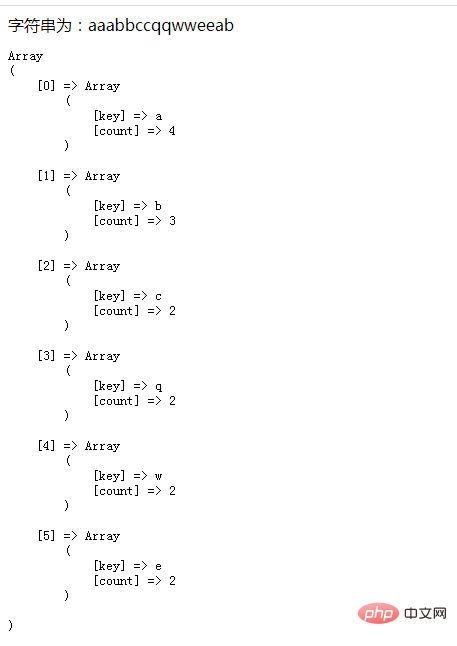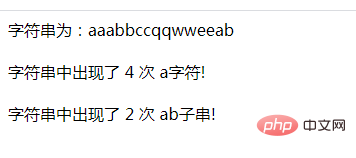 Backend Development
Backend Development
 PHP Tutorial
PHP Tutorial
 PHP string learning counts the number of occurrences of characters
PHP string learning counts the number of occurrences of characters
PHP string learning counts the number of occurrences of characters
In the previous article, we introduced a case-insensitive method of replacing a given substring with other values. If you are interested, you can click on the link to check → "PHP cleverly uses functions to replace a given substring with * Number (case insensitive) 》. This time we will introduce how to use PHP to count the number of occurrences of characters in a string. You can refer to it if necessary.
I believe that given a string "aaabbccqqwweeab", how to count the number of occurrences of each character? You can use the loop
<?php
header("Content-Type: text/html;charset=utf-8"); //设置字符编码
//统计字符串中出现的字符,出现次数
$str = 'aaabbccqqwweeab';//字符串示例
echo "字符串为:".$str.'<br/>';
$strRecord=array();//把出现过的字符记录在此数组中,如果记录有,则不记录,
for($i=0;$i<strlen($str);$i++){
$found = 0;//默认设置为没有遇到过
foreach((array)$strRecord as $k=>$v){
if($str[$i] == $v['key']){
$strRecord[$k]['count'] += 1;//已经遇到,count + 1;
$found = 1;//设置已经遇到过的,标记
continue;//如果已经遇到,不用再循环记录数组了,继续下一个字符串比较
}
}
if(!$found){
$strRecord[] = array('key'=>$str[$i],'count'=>1);//记录没有遇到过的字符串
}
}
echo '<pre class="brush:php;toolbar:false">';
print_r($strRecord);
?>to analyze:
Loop the $str string once and record the characters that have appeared in the $strRecord array (only record once, if repeated, Just ignore it).
Traverse the $strRecord array and compare each character in the string (
$str[$i]) with the value of the array ($strRecord[ ]['key']) for comparison; if a value in the record is the same as this character, record the number of times ($strRecord[]['count']) 1.
Let’s take a look at the output:

OK, the statistics are out!
But sometimes we don’t need to count all characters, we only need to count the number of occurrences of a specified character/substring. How to do this?
This is also simple, PHP provides a built-in function to solve this problem. Let's take a look at the following example:
<?php
header("Content-Type: text/html;charset=utf-8"); //设置字符编码
$str = 'aaabbccqqwweeab';
echo "字符串为:".$str.'<br/><br/>';
echo "字符串中出现了 ".substr_count($str,'a')." 次 a字符!";
echo "<br/><br/>字符串中出现了 ".substr_count($str,'ab')." 次 ab子串!";
?>Analysis: We use "substr_count($str,'a')" and "substr_count($str,'ab') " statement to count the number of occurrences of the "a" character and the "ab" character in the string $str. What do you think this will output? Should "4" and "2" be output? So right? Let's take a look at the output:

Correct! The number of occurrences of the "a" character and the "ab" character is "4" and "2".
Let’s take a look at the key function substr_count().
The substr_count() function can count the number of times a substring (consisting of one or more characters) appears in a string (case-sensitive).
substr_count($string,$substring,$start,$length)The function accepts 2 required parameters $string and $substring, and 2 omitted parameters $start and $length.
We already know the first two required parameters through the above code example. Let's take a look at the two omitted parameters $start and $length.
$start: used to specify where to start searching for substrings in the string
$length: used to specify the length of the search
The value returned by the substr_count() function is also different depending on the values set by the parameters $start and $length.
<?php
header("Content-Type: text/html;charset=utf-8"); //设置字符编码
$str = 'aaabbccqqwweeab';
echo "字符串为:".$str.'<br/><br/>';
echo "字符串中出现了 ".substr_count($str,'a',0,5)." 次 a字符!";
echo "<br/>字符串中出现了 ".substr_count($str,'a',2,5)." 次 a字符!";
echo "<br/><br/>字符串中出现了 ".substr_count($str,'ab',0,10)." 次 ab子串!";
echo "<br/>字符串中出现了 ".substr_count($str,'ab',3)." 次 ab子串!";
?>Output result:
Okay, that’s all. If you want to know anything else, you can click this. → →php video tutorial
Finally, I recommend reading a classic course "PHP String Processing (Jade Girl Heart Sutra Edition)", it's free~ come and learn !
The above is the detailed content of PHP string learning counts the number of occurrences of characters. For more information, please follow other related articles on the PHP Chinese website!

Hot AI Tools

Undresser.AI Undress
AI-powered app for creating realistic nude photos

AI Clothes Remover
Online AI tool for removing clothes from photos.

Undress AI Tool
Undress images for free

Clothoff.io
AI clothes remover

Video Face Swap
Swap faces in any video effortlessly with our completely free AI face swap tool!

Hot Article

Hot Tools

Notepad++7.3.1
Easy-to-use and free code editor

SublimeText3 Chinese version
Chinese version, very easy to use

Zend Studio 13.0.1
Powerful PHP integrated development environment

Dreamweaver CS6
Visual web development tools

SublimeText3 Mac version
God-level code editing software (SublimeText3)

Hot Topics
 1672
1672
 14
14
 1428
1428
 52
52
 1332
1332
 25
25
 1276
1276
 29
29
 1256
1256
 24
24
 PHP vs. Python: Understanding the Differences
Apr 11, 2025 am 12:15 AM
PHP vs. Python: Understanding the Differences
Apr 11, 2025 am 12:15 AM
PHP and Python each have their own advantages, and the choice should be based on project requirements. 1.PHP is suitable for web development, with simple syntax and high execution efficiency. 2. Python is suitable for data science and machine learning, with concise syntax and rich libraries.
 PHP: A Key Language for Web Development
Apr 13, 2025 am 12:08 AM
PHP: A Key Language for Web Development
Apr 13, 2025 am 12:08 AM
PHP is a scripting language widely used on the server side, especially suitable for web development. 1.PHP can embed HTML, process HTTP requests and responses, and supports a variety of databases. 2.PHP is used to generate dynamic web content, process form data, access databases, etc., with strong community support and open source resources. 3. PHP is an interpreted language, and the execution process includes lexical analysis, grammatical analysis, compilation and execution. 4.PHP can be combined with MySQL for advanced applications such as user registration systems. 5. When debugging PHP, you can use functions such as error_reporting() and var_dump(). 6. Optimize PHP code to use caching mechanisms, optimize database queries and use built-in functions. 7
 PHP and Python: Comparing Two Popular Programming Languages
Apr 14, 2025 am 12:13 AM
PHP and Python: Comparing Two Popular Programming Languages
Apr 14, 2025 am 12:13 AM
PHP and Python each have their own advantages, and choose according to project requirements. 1.PHP is suitable for web development, especially for rapid development and maintenance of websites. 2. Python is suitable for data science, machine learning and artificial intelligence, with concise syntax and suitable for beginners.
 PHP in Action: Real-World Examples and Applications
Apr 14, 2025 am 12:19 AM
PHP in Action: Real-World Examples and Applications
Apr 14, 2025 am 12:19 AM
PHP is widely used in e-commerce, content management systems and API development. 1) E-commerce: used for shopping cart function and payment processing. 2) Content management system: used for dynamic content generation and user management. 3) API development: used for RESTful API development and API security. Through performance optimization and best practices, the efficiency and maintainability of PHP applications are improved.
 The Enduring Relevance of PHP: Is It Still Alive?
Apr 14, 2025 am 12:12 AM
The Enduring Relevance of PHP: Is It Still Alive?
Apr 14, 2025 am 12:12 AM
PHP is still dynamic and still occupies an important position in the field of modern programming. 1) PHP's simplicity and powerful community support make it widely used in web development; 2) Its flexibility and stability make it outstanding in handling web forms, database operations and file processing; 3) PHP is constantly evolving and optimizing, suitable for beginners and experienced developers.
 PHP and Python: Different Paradigms Explained
Apr 18, 2025 am 12:26 AM
PHP and Python: Different Paradigms Explained
Apr 18, 2025 am 12:26 AM
PHP is mainly procedural programming, but also supports object-oriented programming (OOP); Python supports a variety of paradigms, including OOP, functional and procedural programming. PHP is suitable for web development, and Python is suitable for a variety of applications such as data analysis and machine learning.
 PHP vs. Other Languages: A Comparison
Apr 13, 2025 am 12:19 AM
PHP vs. Other Languages: A Comparison
Apr 13, 2025 am 12:19 AM
PHP is suitable for web development, especially in rapid development and processing dynamic content, but is not good at data science and enterprise-level applications. Compared with Python, PHP has more advantages in web development, but is not as good as Python in the field of data science; compared with Java, PHP performs worse in enterprise-level applications, but is more flexible in web development; compared with JavaScript, PHP is more concise in back-end development, but is not as good as JavaScript in front-end development.
 PHP and Python: Code Examples and Comparison
Apr 15, 2025 am 12:07 AM
PHP and Python: Code Examples and Comparison
Apr 15, 2025 am 12:07 AM
PHP and Python have their own advantages and disadvantages, and the choice depends on project needs and personal preferences. 1.PHP is suitable for rapid development and maintenance of large-scale web applications. 2. Python dominates the field of data science and machine learning.




